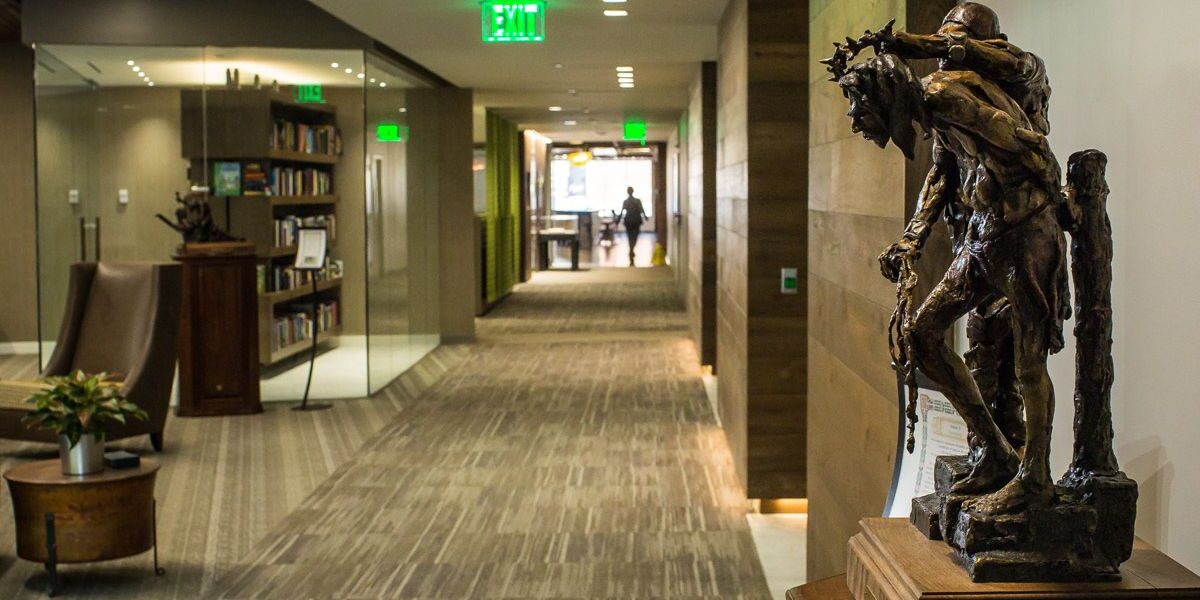I don’t always see Christ around me, especially in my daily grind. My workdays normally involve grabbing a cup of coffee, plugging away at deadlines and bantering with coworkers. Most of the time I am focused on the task, or person, right in front of me. I often lose sight of the sacred in the ordinary.
But sometimes Christ’s presence breaks into my life in unexpected ways.
Several weeks ago, I joined a small group of coworkers to walk the Stations of the Cross. We didn’t have to go far to take our pilgrimage. A priest led us through the familiar halls of our office to reflect on fourteen bronze statues on loan to American Bible Society. The statues are replicas by artist Gib Singleton. Each one is strategically placed in our workspace—down the hallways, on the stairs, next to meeting rooms. Some are immediately visible, others I hadn’t noticed; each takes up a little space amid the normal office buzz.
The Stations of the Cross
The Stations of the Cross are an ancient church tradition that guides us on a walk through the final events of Jesus’ life—his betrayal, trial and crucifixion. Each of the fourteen stations are accompanied by prayers and Scripture readings. Typically the stations are commemorated by pieces of artwork on the walls of a church sanctuary. The stations are often incorporated into Good Friday services, when the liturgical calendar focuses on Jesus’ suffering and death.
While I have experienced walking the Stations in several churches, I had never considered how these events—that seem so long ago and far away—could draw near to me, playing out in the context of my own life. I reflected on the images and read the Scripture passages, but Jesus’ betrayal by Judas stayed in the Garden of Gethsemane. His violent beating stayed outside the walls of his trial. Jesus dragged his cross on the distant streets of Jerusalem.
Walking the Stations
As I walked through the office, these events were brought close—materializing around me. The stairwell became the Mount of Olives and the halls became the streets of Jerusalem. My coworkers became participants in the story—shopkeepers and other ordinary people rushing from place to place. At each station I saw Jesus’ story quietly emerging—his suffering interrupting life on the crowded streets.
I saw the anguish on Jesus’ face at Judas’ betrayal—which the artist expressed through chunky pieces of bronze that looked like flesh (Station 2; Mark 14:43-46).
I felt the towering presence of Jesus’ oppressors through the placement of the statues. A Roman soldier bent over Jesus, as he lay prostrate on the ground. Our small group gathered closer, creating our own scene of spectators (Station 7; John 19:6, 15-17).
I felt Jesus’ vulnerability on the cross—his ribs protruding in sharp angles. Our group stood professionally dressed, as Jesus hung exposed. I found myself wanting to look away in shame (Station 10; Luke 23:33-34).
I stood before Mary cradling her limp son in her arms. I sensed her heartbreak as she looked down into Jesus’ face and my own heart stirred to empathy. As a coworker rushed by en route to a meeting, I wanted to protect Mary’s moment of intimacy. I longed to acknowledge her grief—to let her lament in privacy (Station 13; Luke 23:44-49).
When I arrived at Jesus’ tomb, he lay alone and still. I noticed how the sculptor had highlighted the body with a golden film. The other statues were cast more darkly; now, in death, Jesus looked even more alive. The suffering and ridicule were over, making him seem more approachable, close enough to stand beside and talk to (Station 14; Matthew 27:57-60).
After we concluded our walk, I went back to my desk—this time noticing the statues along the way. I recognized the scenes they depicted as places where I had spent time, moments in Jesus’ life I had encountered. Even in passing, I could identify the characters. I recognized the Roman soldiers, the disciples, Mary and Jesus. I noticed traces of the same golden film that highlighted Jesus’ body, highlighting features on each one of them. How did I miss that before? I wondered.
A Greater Awareness
A few weeks later I attended a Holy Week class at my church. An older gentleman shared with the group, “Every year I cry when the choir sings, ‘Were You There When They Crucified My Lord?’ I don’t know why, but it always moves me.” I could see his eyes moisten as he recalled the memory. Neither of us was there on that day—when Jesus hung from a cross on Calvary. We don’t know what Jesus’ last cry sounded like, what stenches filled the air. We can’t name the disciples who knelt beneath his cross, or count the wounds on his body. But walking the Stations of the Cross brought these events a little closer. They reminded me that Christ is always breaking into our stories. Even when we don’t recognize him.
Interested in learning more about the last days of Jesus’ life? Curious about what happens next?
Click here for helpful articles about the final events of Jesus’ life.





